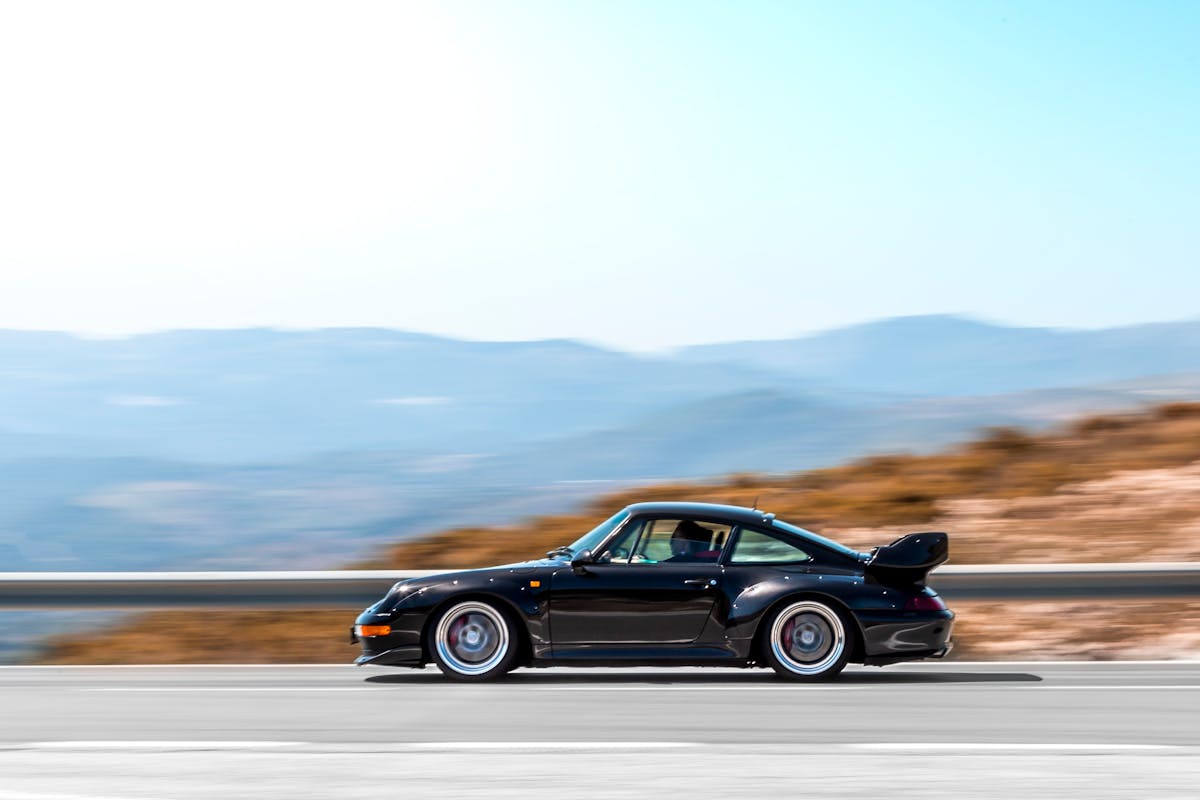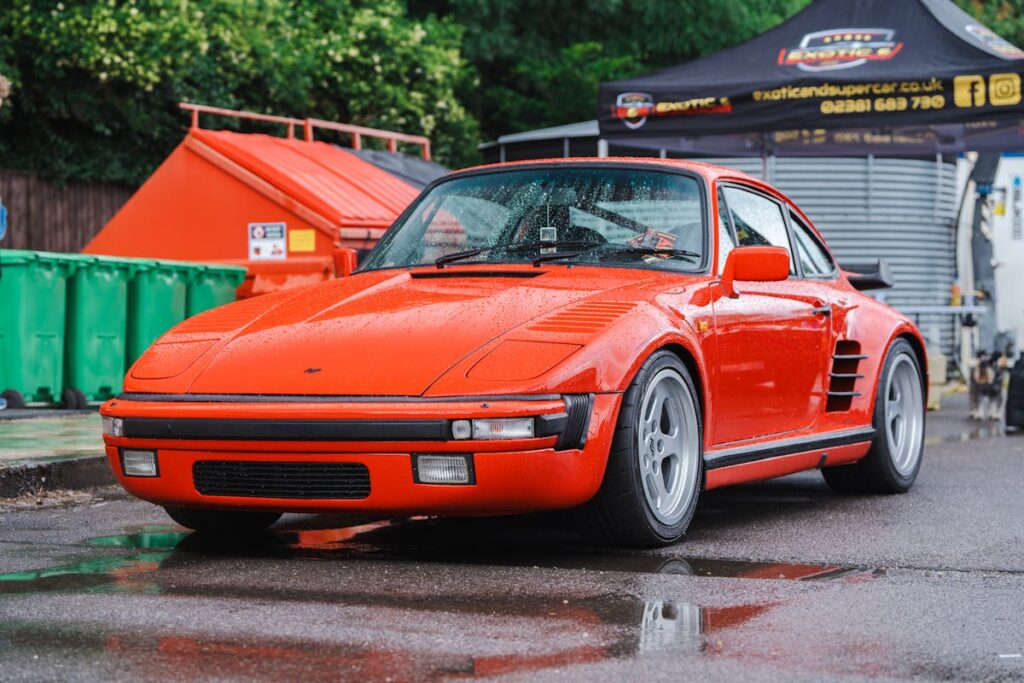The 1988 Porsche 911, a marvel of German engineering, continues to captivate the hearts of car enthusiasts and collectors, asserting its timeless appeal in the automotive domain. Renowned for its exceptional performance, luxurious interior, and distinctive design, this classic car represents a perfect fusion of form and function. As we explore the unique attributes that elevate this model to its coveted status, we invite you to reflect upon its growing value and enduring significance in the domain of classic automobiles.
Unveiling the 1988 Porsche 911
Revealed amidst much anticipation, the 1988 Porsche 911 emerged as a masterpiece in automotive engineering. This vehicle, a reflection of the Porsche Legacy, was a marvel regarding performance, handling, and aesthetics. The design was a refined evolution of its predecessor, combining Porsche’s trademark style with innovative new features.
Mechanically, the 1988 Porsche 911 showcased a 3.2-liter flat-six engine, which was capable of generating an impressive 217 horsepower. This was paired with the acclaimed G50 transmission, offering the driver smooth and precise control. The handling characteristics were further enhanced by the addition of anti-roll bars, increasing the overall stability of the vehicle.
The Classic Restoration process of the 1988 Porsche 911 is an intricate task, requiring a detailed understanding of the vehicle’s original specifications and design elements. Restorers often take great lengths to preserve the originality of the vehicle, ensuring that every detail aligns with the Porsche Legacy. This includes the sourcing of original parts and materials, and meticulous attention to detail in restoring the car’s bodywork, interior, and engine to their original glory. The 1988 Porsche 911, as a result, remains an enduring symbol of the brilliance of Porsche’s automotive engineering.
A Brief History of the Porsche 911
While the 1988 Porsche 911 model is indisputably a remarkable representation of Porsche’s mastery in automotive engineering, its roots can be traced back to the inception of the iconic Porsche 911 series. Introduced in 1963 at the Frankfurt Motor Show, the Porsche 911 was initially met with some skepticism due to its rear-engine design. However, it quickly proved its mettle, winning both the admiration of car enthusiasts and numerous racing accolades.
Over the years, the Porsche 911 series has continued to evolve, with each iteration reflecting technological advancements while maintaining the brand’s signature style and performance. The 911’s design reflects the Porsche heritage, with a focus on providing a seamless blend of luxury, power, and usability. The 1988 model, in particular, stands as a demonstration of the 911 legacy, encapsulating the evolution of the series and marking a high point in Porsche’s production history.
Despite numerous updates and modifications, Porsche has managed to preserve the 911’s iconic design, ensuring its timeless appeal. This consistency underlines Porsche’s commitment to its heritage, ensuring the 911 remains a symbol of the brand’s enduring prowess in the automotive industry. The 911 series embodies the Porsche legacy, linking its illustrious past to its innovative future.
Iconic Design Elements of the ’88 Porsche
The 1988 Porsche 911 displays a multitude of iconic design elements that highlight its remarkable blend of form and function. Emblematic of the classic aesthetics that Porsche is renowned for, the ’88 model is a reflection of the company’s enduring design legacy.
One cannot overlook the 911’s signature profile, a sleek, aerodynamic silhouette that communicates speed even at a standstill. Its wide, rounded wheel arches house large diameter alloy wheels, a design innovation of its time that contributed to superior handling and stability.
The front end, with its distinctive round headlamps and prominent air intakes, is immediately recognizable, embodying the design DNA that Porsche has faithfully preserved over the decades. The rear-end, characterized by a unique ‘whale tail’ spoiler, not only contributes to the car’s aerodynamic performance but also stands as an iconic design hallmark.
Inside, the 911’s cockpit-style cabin, complete with a three-spoke steering wheel and five circular instrument gauges, underscores the car’s sports car DNA. The familiar layout, with its focus on driver-centric ergonomics, is a perfect example of form meeting function.
This intricate blend of iconic design elements underscores the 1988 Porsche 911’s status as a cherished classic, representing the pinnacle of Porsche’s design ethos.
The Power Behind the Porsche
The Power Behind the Porsche is encapsulated in its impressive engine capabilities and constant evolution of speed. Releasing the engine capabilities of Porsche 911 reveals a powerful machine that has been refined over decades to offer unparalleled performance. This mirrors its parallel journey in speed evolution, which has seen a consistent pursuit of greater velocity, making it a force to be reckoned with on the track.
Unleashing Engine Capabilities
With an uncanny knack for merging luxury and performance, Porsche’s 911 model encapsulates the very essence of automotive excellence. One of the fundamental elements that contribute to this excellence is the 911’s engine capabilities, which can be additionally enhanced through precise engine tuning and specific performance upgrades.
Engine tuning for the 911 model is a meticulous process that involves adjusting and modifying the internal combustion engine to obtain ideal performance levels. This intricate procedure, when done correctly, can greatly enhance power output, fuel efficiency, and overall performance. Moreover, it can help to maintain the engine’s longevity, enabling the 911 to perform at its peak for extended periods.
Performance upgrades, on the other hand, can range from simple bolt-on additions to more complex modifications. These enhancements are designed to boost the engine’s horsepower, torque, and overall capacity, thereby pushing the boundaries of the car’s performance. These upgrades may include turbochargers, exhaust systems, or cold air intake systems, each providing a unique benefit to the engine’s performance.
Evolution of Speed
Engine enhancements and performance upgrades, as discussed, form a notable part of the Porsche 911’s appeal. However, the 911’s speed advancements cannot be overlooked. Its racing heritage and continual evolution of speed underpin the brand’s reputation and collector’s appeal.
The 911’s evolution of speed can be seen through three key developments:
- The introduction of turbochargers: The Porsche 911 Turbo, first introduced in 1975, leveraged the power of turbocharging technology, markedly increasing the car’s top speed and acceleration, setting a new performance standard in the industry.
- Development in aerodynamics: Porsche invested heavily in research to optimize the 911’s aerodynamics, reducing drag and further enhancing speed capabilities. The car’s distinctive rear spoiler, for instance, was not merely an aesthetic choice but a strategic one, designed to increase downforce and stability at high speeds.
- Incorporation of advanced materials: Porsche began utilizing lightweight materials such as aluminium and carbon fibre. This reduced the car’s weight, thereby improving speed and handling without compromising structural integrity.
Through these advancements, the 1988 Porsche 911 exemplifies the brand’s commitment to speed and performance, reflecting its illustrious racing heritage. This continual pursuit of speed evolution is what makes the 911 a collector’s dream on wheels.

The 1988 Porsche 911 Performance Breakdown
Exemplifying pure power and raw beauty, the 1988 Porsche 911 stands as an undeniable demonstration to the mastery of automotive engineering. Its performance credentials are underpinned by the engine specifications, showcasing an air-cooled 3.2-liter horizontally opposed six-cylinder engine that is capable of producing 217 horsepower and 195 pound-feet of torque. This powerplant is mated to a G50 five-speed manual transmission, which replaced the previous 911’s four-speed, leading to enhanced performance and smoothness in driving experience.
The handling dynamics of the 1988 Porsche 911 are just as impressive as its power output. The rear-engine layout, a signature of the 911 series, offers exceptional traction, allowing the car to maintain grip and composure even in high-speed cornering scenarios. The suspension system, with its torsion bar setup, contributes to a perfect balance between comfortable ride quality and sporty handling. Additionally, the responsive steering and effective brakes add to the vehicle’s overall dynamic capability.
Inside the Luxurious 1988 Porsche 911
Stepping inside the 1988 Porsche 911, one is immediately enveloped in an atmosphere of luxury and refinement that matches the car’s impressive performance capabilities. The cabin, a harmonious blend of tradition and modernity, boasts luxurious interiors crafted with meticulous attention to detail.
- The seats are contour-hugging, upholstered in premium materials that provide a tactile and visual treat. The fine leather, in a range of classic and contemporary hues, complements the car’s style while ensuring comfort on the road.
- The dashboard, a masterpiece of ergonomic design, is intuitively laid out. The iconic five-gauge cluster, a nod to the Porsche heritage, sits behind a three-spoke steering wheel. The controls are all within easy reach, enhancing the driver’s experience.
- The 911’s cabin is not just about beauty and comfort, it also features cutting-edge technology. The stereo system, air conditioning, and other gadgetry are seamlessly integrated, offering a perfect balance between luxury and functionality.
The 1988 Porsche 911 encapsulates the brand’s commitment to delivering an unparalleled motoring experience. Its luxurious interiors, crafted from premium materials, are a demonstration of Porsche’s dedication to quality, style, and comfort. This classic car, with its timeless appeal, continues to captivate both drivers and collectors alike.
Why Collectors Covet the 1988 Porsche 911
The allure of the 1988 Porsche 911 for collectors is multifaceted, hinging on its iconic design elements, superior performance characteristics, and a remarkable trend of investment value growth. The car’s design, particularly its distinctive silhouette, has not only endured but has become emblematic of the brand’s commitment to aesthetic excellence. Its performance metrics, rooted in the precision engineering of the era, continue to impress, while its steadily appreciating value makes it a compelling choice for discerning collectors.
Iconic Design Elements
Adored by enthusiasts worldwide, the 1988 Porsche 911 is a tribute to timeless elegance and engineering prowess. Its design legacy is a demonstration of the aesthetic influence it has exerted over the automotive industry. The Porsche 911’s iconic design elements are not just mere visual treats but are also emblematic of the brand’s commitment to innovation, comfort, and performance.
Here are three key design elements that make the 1988 Porsche 911 a collector’s dream:
- The Signature Sloping Roofline: The 911’s silhouette, with its distinctive sloping roofline, is instantly recognizable. This design element not only enhances the car’s aerodynamics but also contributes to its unmistakable identity.
- The Rear-Engine Layout: This unique design choice provided the 911 with excellent weight distribution, greatly improving its handling dynamics. It’s a tribute to Porsche’s engineering prowess and a key reason for the 911’s legendary performance reputation.
- The ‘Frog Eye’ Headlights: These round, prominent headlights became a hallmark of the 911’s design legacy. They not only provide excellent illumination but also contribute considerably to the car’s aesthetic appeal and character.
Superior Performance Characteristics
Beyond its timeless aesthetics, the allure of the 1988 Porsche 911 lies in its superior performance characteristics. This sports car delivers exceptional track performance that continues to captivate enthusiasts and collectors around the world. Its 3.2-liter flat-six engine, capable of producing 217 horsepower, and a top speed of 152 mph, gave it a competitive edge during its time.
The 1988 Porsche 911’s handling dynamics are another reason why it remains a collector’s favorite. Its rear-engine layout and distinctive suspension design make it a unique driving machine. The car’s impeccable balance, sharp steering, and superior road grip, all contribute to an exhilarating driving experience that is rarely replicated in modern sports cars.
In terms of acceleration, the 1988 Porsche 911 does not disappoint. It can sprint from 0 to 60 mph in just 5.5 seconds, a figure that was quite impressive for a car of its era. The braking system of the car is equally commendable, offering a strong, confident stopping power.
Investment Value Growth
While the superior performance characteristics of the 1988 Porsche 911 unquestionably contribute to its appeal, collectors are equally drawn by its growing investment value. This value is influenced by a combination of market trends, scarcity, and the car’s enduring allure.
- Market Trends: The classic car market has consistently grown over the past decade, with certain models like the 1988 Porsche 911 experiencing significant appreciation. As collectors and enthusiasts continue to recognize the intrinsic importance of these vehicles, these market trends are expected to continue.
- Scarcity: The 1988 Porsche 911 was produced in limited quantities, making it a rare find. This scarcity inherently increases its value as collectors compete to acquire these prized vehicles.
- Enduring Allure: The 1988 Porsche 911 is more than just a car; it is a symbol of automotive history and design innovation. Its appeal transcends time, making it a desirable asset for collectors.
Future projections indicate that the 1988 Porsche 911’s investment value will continue to grow, making it a sound financial asset. Collectors don’t just buy these cars for their performance, they buy them as investments, banking on their enduring allure and the continuing trends in the collector car market.
Preserving Your 1988 Porsche 911 Investment
For countless enthusiasts, the 1988 Porsche 911 is more than just a vehicle; it’s a tangible investment that appreciates with time. Its timeless appeal hinges on the preservation of its original condition, making regular maintenance and careful restoration vital.
Proper care begins with routine maintenance checks. Regular engine oil changes, tire rotations, and inspections of the brake system are fundamental to preserving the car’s integrity. Significantly, the 1988 Porsche 911’s air-cooled engine requires a meticulous maintenance approach, given its unique cooling method compared to modern water-cooled engines.
Equally important is the car’s cosmetic upkeep. To maintain its pristine appearance, consider professional detailing services that specialize in classic vehicles. This includes thorough interior and exterior cleaning, waxing, and polishing.
Restoration options should only be explored when necessary, as preserving original parts is essential for value appreciation. If unavoidable, seek out specialists in Porsche restoration to guarantee the work is carried out meticulously and in line with the vehicle’s original specifications.
In essence, preserving your 1988 Porsche 911 investment necessitates a blend of regular maintenance, potential restoration, and an unwavering commitment to its original condition. These efforts will guarantee the vehicle continues to appreciate, cementing its status as a collector’s dream on wheels.
Frequently Asked Questions
What Is the Average Resale Value of the 1988 Porsche 911?
The average resale value of the 1988 Porsche 911 fluctuates based on factors such as condition and mileage. Given current resale trends and market demand, it typically ranges between $70,000 to $100,000.
How Does the Fuel Consumption of the 1988 Porsche 911 Compare to Modern Cars?
The 1988 Porsche 911, while a classic, does not match modern vehicles regarding fuel efficiency. Compared to contemporary cars, it has higher fuel consumption and greater vintage car emissions, reflecting advancements in automotive technology.
Are There Any Notable Celebrities or Public Figures Known to Own a 1988 Porsche 911?
Several celebrities value the 1988 Porsche 911 for its timeless appeal. Particularly, comedian Jerry Seinfeld, a noted car collector, owns this vintage model, affirming its status as a coveted piece among automobile enthusiasts.
What Are Some Common Maintenance Issues With the 1988 Porsche 911?
The 1988 Porsche 911, while renowned for its engine reliability, does present some common maintenance issues. Particularly, suspension wear is frequently reported, necessitating regular checks and potentially costly part replacements to guarantee peak performance.
Are There Any Specific Insurance Considerations for the 1988 Porsche 911 Due to Its Collectors Status?
Yes, collector insurance considerations for the 1988 Porsche 911 include its rarity and condition. Valuation factors such as market demand, originality, and provenance also greatly influence insurance premiums for this classic automobile.

